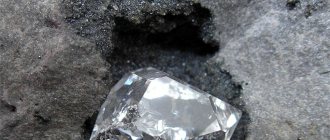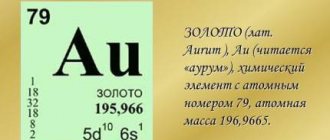Everyone knows that diamond is the most precious stone on earth. It is unique in that it is the hardest, most radiant and sparkling among minerals; its external characteristics are not subject to time, mechanical damage and even fire. Both thousands of years ago and now, diamonds attract humanity, beckoning with their cold beauty. Processed diamonds not only produce magnificent diamonds that adorn luxury jewelry, they are also (due to their properties) used in many industrial sectors. There are enough deposits where diamonds can be found in Russia to say that our country is a diamond power. In this article we will tell you more about the extraction of such a useful and beautiful mineral. So, further about where diamonds are mined in Russia: cities, location of deposits.
Diamonds in nature
In the upper mantle of the Earth, at a depth of more than 100-150 km, under the influence of high temperatures and enormous pressure, pure carbon atoms from the graphite state are modified into crystals, which we call diamonds. This crystallization process takes hundreds of years. After spending several million years in its depths, diamonds are brought to the surface of the earth by kimberlite magma during volcanic explosions. With such an explosion, so-called pipes are formed - kimberlite diamond deposits. The name “kimberlite” comes from the African town of Kimberley, in the area of which diamond-bearing rock was discovered. Nowadays, there are two types of diamond deposits: primary (lamproite and kimberlite) and secondary (placers).
Diamonds were known to mankind three thousand years before our era; the first mentions of them were found in India. People immediately endowed diamond with supernatural properties, thanks to its indestructible hardness, brilliance and transparent purity. It was accessible only to selected persons who had power and authority.
Chemistry of precious minerals
| Formula | C |
| Molecular weight | 12.01 |
| Impurity | N |
| IMA status | valid |
| Class | Native elements |
| Group | Carbon polymorphs |
| Color | Colorless, yellow, brown, blue, light blue, green, red, pink, black |
| Stroke color | Absent |
| Shine | Diamond |
| Transparency | Transparent |
| Hardness | 10 |
| Fragility | fragile |
| Cleavage | Perfect by {111} |
| Kink | Conchoidal to splintery |
| Density | 3.47—3.55 g/cm³ |
| Point group | m3m (4/m -3 2/m) -hexoctahedral |
| Space group | Fd3m (F41/d -3 2/m) |
| singonia | Cubic |
| Twinning | Twins of germination according to the spinel law are common |
| Optical type | isotropic |
| Refractive index | 2,417—2,419 |
| Birefringence | absent, since optically isotropic |
| Optical relief | moderate |
| Optical axis dispersion | strong |
| Pleochroism | does not pleochroate |
| Luminescence | blue, green, yellow, red |
The chemical composition of diamonds is impressive. There is no more complex stone in nature. It contains elements such as silicon, aluminum, calcium, magnesium, sodium, barium, manganese, iron, chromium and even titanium. But the main impurity is nitrogen. Its amount in a mineral plays a very important role and a lot depends on it.
Based on nitrogen content, diamonds are divided into two types:
- Type 1 - the nitrogen content in the stone is approximately a quarter of the total volume of impurities. This type is not transparent to ultraviolet radiation;
- Type 2 – nitrogen content is only one thousandth of the total volume. They are called nitrogen-free diamonds.
It is the nitrogen content in a precious mineral that is responsible for its color, X-ray scattering, luminescence, and the like.
Diamond producing countries
Since each diamond is unique in its kind, it is customary to separate their accounting among world countries according to production volumes and in value terms. The bulk of diamond production is distributed among only nine countries. These are Russia, the Republic of Congo, Botswana, Australia, Canada, Angola, South Africa, Zimbabwe and Namibia.
In value terms, the leaders among these countries are Russia, African Botswana and Canada. Their total diamond production accounts for more than 60% of the value of the world's mined diamonds.
For incomplete 2021 (according to the latest data), Russia takes first place in terms of production volumes and value. Its share in value terms accounts for about 40% of total world production. This leadership has belonged to Russia for several years.
The first diamond in the Russian Federation
Now in more detail about production in our country. When and where did diamond mining in Russia first begin? This happened in the 19th century, in the summer of 1829, the serf teenager Pavel Popov, panning for gold at the Krestovozdvizhensky gold mine in the Perm province, found an incomprehensible pebble. The boy gave it to the caretaker and after assessing the precious find, he was given his freedom, and all other workers were told to pay attention to all the transparent stones. So two more diamonds were found. Humboldt, a former German geologist nearby, was told about the place where diamonds are mined in Russia. Then the development of the diamond mine began.
Over the next thirty years, about 130 diamonds were discovered, weighing a total of 60 carats. In total, before 1917, no more than 250 precious stones were found in Russia, where diamonds were mined in the Urals. But, despite the insignificant number, they were all of excellent beauty. These were stones worthy of decorating jewelry.
Already in 1937, large-scale expeditions were organized in Soviet Russia to explore Ural diamonds, but they were not crowned with great success. The placers found were poor in precious stone content; primary diamond deposits were never discovered in the Urals.
Technological cycle
Deposit development and diamond mining is a very costly, knowledge-intensive undertaking that requires large financial investments.
Capital investments go towards geological exploration, calculations, laboratory research, specialized equipment, construction of processing plants near the deposit, preparatory work for deposits, registration of a huge number of documents, and remuneration of hired employees.
This is not a matter of 1 year, but several years of hard work.
Diamond before and after processing
It takes a lot of time to organize diamond mining in large volumes in order to not only recoup the money invested, but also make good money.
Technological cycle:
- Geological exploration work. Labor-intensive work that requires financial investment. You can spend several years on it and find nothing. If a potential location for diamond mining is found, calculations are carried out to accurately determine whether it is large or isolated. An error in calculations is unacceptable, otherwise you can spend a huge amount of money and earn nothing.
- Purchase of specialized equipment. Special equipment for developing mines, moving rocks, etc.
- Organization of infrastructure. Large deposits require employment of a large number of people for many years. The construction of residential buildings, hospitals, kindergartens, shops, and organization is included in the cost of field development. Often small towns are formed near them, most of the population of which work in mining. Thanks to the close proximity of cities near the fields, production can take place around the clock.
- Construction of a processing plant. Selling raw materials will not bring the desired profit, so processing plants are built near the deposits, where stones are sorted, selected and sent to cutting factories, where they are processed, cut, and polished. A finished, well-processed product costs many times more.
Large financial investments are required to develop deep-lying rocks. At such deposits, it is necessary to process up to 1 ton of mine rocks to obtain 1 carat of diamonds. “Rich” placers – 1 ton of ore – up to 5 carats.
Siberian diamonds
Since the 18th century, the best minds of our country have wondered where the diamond deposits are in Russia. The great Russian scientist of the 18th century, Mikhail Lomonosov, stated in his writings that Siberia could be a diamond-bearing region. He outlined his assumption in the manuscript “Diamonds Could Have Occurred in the Northern Lands.” However, the first Siberian diamond was found at the end of the 19th century on the Melnichnaya River, near the city of Yeniseisk. Due to the fact that it weighed only two-thirds of a carat, and also due to a lack of funding, exploration of other diamonds in the area was not continued.
And only in 1949 in Yakutia on the Sokolinaya Spit, near the village of Krestya in the Suntarsky Ulus, the first Siberian diamond was found. But this deposit was alluvial. The search for indigenous kimberlite pipes was crowned with success five years later - the first pipe not located in Africa was found near the Daldyn River by geologist Popugaeva. This was a significant discovery in the life of our country. The name of the first diamond-bearing pipe was given in the Soviet style of that time - “Zarnitsa”. The next to be discovered were the Mir pipe and the Udachnaya pipe, where diamonds are still mined in Russia. By the end of 1955, 15 new diamond pipe deposits appeared in Yakutia.
Yakutia, or as the locals call this region, the Republic of Sakha, is the place where gold and diamonds are mined in Russia. Despite the severity of the climate, it is a fertile and generous region, giving our country natural resources.
Below is a map that clearly shows where these precious stones are mined in Russia. The darkest territories are the places where there are the largest number of deposits, and the diamonds themselves are the most expensive in value. As you can see, most of the pipes are concentrated in the Republic of Sakha (Yakutia). There are also diamonds in the Krasnoyarsk Territory, Irkutsk Region, the Republic of Karelia, the Arkhangelsk and Murmansk Regions, the Perm Territory, the Komi Republic and so on.
How to distinguish real from fake?
The authenticity of a diamond can be determined in different ways. Some can be used independently, others require the intervention of a specialist. The following recommendations will help you distinguish a diamond from a fake:
- A real crystal is never framed in silver or other cheap metal. A similar mineral in jewelry is presented only in combination with expensive metals - platinum or gold.
- If the stone has a flat and smooth surface without the presence of cracks or other defects, this indicates that this is a fake that shines and shines beautifully.
- Real specimens are not translucent. If you can read words through the nugget, it’s a fake.
- Diamonds have enormous density. It is necessary to move the stone along the glass, pressing it lightly. The natural mineral will certainly leave a scratch on the glass.
- Faceted stones have a bright shine and play with light. Compared to this radiance, other minerals look dull and pale, even if they have a high-quality cut. Diamond has a high refractive index. Thanks to this, it sparkles strongly in the light.
- Real diamonds never fog up. To check this property, you need to wipe the crystal with a dry flannel cloth and breathe on it for a few seconds. If you have a fake in your hands, then evaporation will form on its surface, the diamond will remain dry.
- Due to their transparency, genuine crystals are not visible in water. By immersing diamond jewelry in liquid, you can quickly determine the authenticity of the nugget.
- Lightly coat the real diamond with vegetable oil, then press it against the glass. You will notice that it sticks to it.
- You can use an ultraviolet lamp to check. It is necessary to illuminate the mineral with rays. If the crystal glows with a bluish tint, then it is 99.9% a natural diamond. If a yellow or green color is present, a synthetic cut or other material may be suspected.
Mirny is the city with the most diamonds in Russia
In the summer of 1955, geologists searching for kimberlite pipes in Yakutia saw a larch tree with exposed roots. This fox dug a hole here. The color of the scattered earth was bluish, which is a characteristic feature of kimberlite. The geologists were not mistaken in their guesses, and after some time they sent a coded message to the top Soviet leadership: “We smoked the pipe of peace, the tobacco is excellent!” A year later, in the west of Yakutia, large-scale development of the Mir kimberlite pipe begins, similar to quarry excavations.
Around a huge quarry in the form of a funnel, a village is formed, named in his honor - Mirny. Within two years, the village turns into the city of Mirny, today it is a city with a population of more than three tens of thousands of residents, 80% of whom are employed in the diamond mining enterprise. It can rightfully be called the diamond capital of Russia, because millions of dollars worth of diamonds are mined here every year.
Now it is the largest quarry not only in Russia, where diamonds are mined, but throughout the world. The depth of the huge quarry is 525 meters, its diameter is about 1200 meters, the quarry could easily accommodate the Ostankino TV tower. And when descending to the center of the quarry, the length of the serpentine road is more than 8 kilometers.
Below in the photo is just this diamond quarry (Mirny, Yakutia).
"Yakutalmaz"
The Yakutalmaz trust was created in 1957 in the tent village of Mirny at that time with the aim of developing mining operations for diamond extraction. Exploration of the following deposits was carried out in the difficult conditions of the deep taiga, with severe frosts of 60 degrees and the absence of any infrastructure. Thus, in 1961, almost near the Arctic Circle, the development of the Aikhal pipe began, and in 1969 another pipe was discovered - the International pipe - the most diamond-bearing pipe to date.
In the 1970s and 1980s, several more diamond mines were opened through underground nuclear explosions. The International, Yubileynaya, and other pipes were discovered in this way. In the same years, Yakutalmaz opened the world’s only kimberlite museum in the city of Mirny. At first, the exhibits represented private collections of geologists, but over time they became more numerous. Here you can see various rocks of kimberlite - a harbinger of diamonds, from different kimberlite pipes around the world.
ALROSA
Since 1992, the legal successor of the Soviet "Yakutalmaz" has become a joint stock company with a state controlling stake. Since its formation, ALROSA has received a state monopoly on exploration, mining and diamond processing activities in the Russian Federation. This group of diamond mining and processing enterprises produces about 98% of all diamonds in Russia.
Today ALROSA has six mining and processing complexes (GOK), four of which are part of the group. These are Aikhal, Udachninsky, Mirny and Nyurbinsky mining and processing plants. Two more plants, Almazy Anabara and Arkhangelsk Severalmaz, are subsidiaries of ALROSA. Each mining and processing plant consists of one or more diamond deposits and a complex of special equipment and processing facilities.
From all mills in Russia, diamonds, no matter where they were mined, are delivered to the Diamond Sorting Center. Here they are assessed, weighed and initially processed. Then the rough diamonds are sent to Moscow and Yakut cutting plants.
Industrial processing of diamond ore
Wet autogenous grinding mill
The extracted rock from diamond mines is sent to processing plants, which are located near the deposits. Since rock layers can reach 1.5 - 2 meters, at the first stage they are crushed into smaller ones. This is done using jaw crushers; the output is raw materials crushed to 50 cm.
At the next stage, the crushed pores are sorted using a vibrating sieve; it consists of several tiers, each subsequent one has smaller fractions. Using pulsating jets of water, the waste rock is separated from the diamond compounds. This method is applied to stones of large and medium fractions.
For fine-grained material, pneumofloration is used - the use of chemical reagents, interacting with water, they form foam to which diamond particles stick.
Pneumatic flotation machine
These methods, along with diamonds, also allow ore particles to pass through, so another cleaning method is used using X-rays.
The conveyor delivers the raw materials to specially equipped containers, where the ore is irradiated; when the beam hits them, the diamonds luminesce, which is responded to by air supply units that blow the stone out of the total mass. This is the most effective cleaning method, but, unfortunately, it does not remove impurities from the stones.
Therefore, the share of manual labor at processing plants is high. After industrial processing, each stone goes through at least three more specialists who remove unnecessary impurities and sort it by size and degree of purity.
The largest deposits in Russia
Among the largest deposits in Yakutia is about. Diamond mining on an industrial scale began here in 1986, and to date the depth of development has reached 320 meters. Further development of Yubileiny up to 720 meters is predicted. Diamond reserves here are estimated at 153 million carats.
The Yubileiny diamond quarry is slightly inferior to the Udachny diamond quarry, which has reserves of precious stones worth 152 million carats. In addition, the Udachnaya pipe was discovered among the very first diamond-bearing pipes in Yakutia in 1955. And although open-pit diamond mining here closed in 2015, underground mining may still continue for several decades. The depth of the Udachny deposit at the time of closure was a world record – 640 meters.
The Mir deposit has also been closed since 2001, and diamond mining here is carried out underground. The oldest quarry also produces surprisingly large diamonds - in 2012, a specimen of 79.9 carats was found. The name of this diamond was given to “President”. True, it is 4 times smaller than the diamond with the name “XXVI Congress of the CPSU” also mined in the Mir pipe in 1980 and weighing 342.5 carats. The total reserves of the Mir quarry are estimated at 141 million carats.
“Yubileiny”, “Udachny”, and “Mir” are the largest diamond deposits not only in Russia, but also in the world.
The Botoubinskaya kimberlite pipe is one of the young, recently developed deposits, also located in Yakutia. Industrial-scale development here began in 2012, and Botouba diamonds entered the world market in 2015. Experts predict that diamond production from this deposit will amount to 71 million carats, and its service life will be at least forty years.
Without a cut you are glass, but with a cut you are a million
After the mine, all diamonds are delivered to the sorting center, which also operates in Mirny. The initial assessment of each stone individually and their sorting by weight takes place here. The largest specimens are selected exclusively by hand by specialists.
Specially trained people closely examine each pebble in order to correctly assess its shape, size, and color. This procedure takes place only with multiple magnification of the stone under special devices, such as various magnifying glasses and a microscope. No less important is the quality of the precious mineral and its transparency.
Each stone that comes into the hands of a specialist is carefully examined three times. Up to a dozen stones can fall through his hands within one hour.
After selecting stones suitable for jewelry making, they are sent to the factory, where they are given the optimal shape. Trained craftsmen approach this issue very scrupulously, since each stone is very expensive and it is simply unacceptable to make a mistake here.
The specialist studies how to properly trim the stone in order to leave the largest carat weight and minimize losses.
It is possible to cut a diamond using exclusively specially designed blades that are coated with diamond coating. As long as the diamond has not been processed, it may not be so expensive. But the moment the stone is cut, its price can increase sharply, even millions of times.
Where are diamonds mined in Russia (except Yakutia)
The opinion that the ALROSA group of companies operates only in cold Yakutia will be erroneous. Moreover, ALROSA is developing deposits not only in Russia, where diamonds are mined, but also in ten other countries.
Indeed, the group’s basic production is concentrated in the Republic of Sakha - in the cities of Yakutsk, Mirny and other cities of Western Yakutia. But there are also representative offices of the joint-stock company ALROSA in other regions of Russia. For example, a subsidiary diamond mining enterprise in the Arkhangelsk region, where the development of diamond deposits began quite recently, about 20 years ago, and the Lomonosov Mining and Processing Plant was opened.
There are also placer diamond deposits in the Perm region. Here they concentrated in the city of Aleksandrovsk and Krasnovishersky district. Although the Permian deposits are not primary, the diamonds mined here are of high quality and are recognized as one of the best for jewelry for their transparency and purity.
ALROSA also has its own representative offices in other cities of Russia, where diamonds are not mined, but processed and turned into polished diamonds. These are Yakutsk, Moscow, St. Petersburg, Orel and a number of other cities.
Extraction methods
There are three types of developments through which gems are mined.
Career
In this way, diamonds are mined at a depth of up to 600, less often 1000 meters. First, wells are drilled and explosives are placed in them. The resulting rock is transported to the processing plant by truck.
Mine
A tunnel is dug deep into the earth to a depth of 500–1000 meters, then infrastructure is built - a ventilation system, elevators, transport for delivering workers, trolleys for mined ore, roads for bulldozers and other equipment.
Placers
Placer diamond deposits make it possible to find crystals without digging holes and tunnels. An ancient and cheap mining method based on washing rock using large sieves.
On the topic of stone mining, watch the video:
ALROSA outside Russia
AK ALROSA conducts major activities in the South African Republic of Angola. Here she owns about 33% of the shares of the local mining company - Africa's largest diamond producer. Cooperation began in 2002, after several meetings at the level of senior management in the capital of the republic, the city of Luanda, an ALROSA branch was opened.
In marketing its specific products, ALROSA has opened several sales branches around the world - in London (UK), Antwerp (Belgium), Hong Kong (China), Dubai (United Arab Emirates), as well as in the USA and Israel. These countries are the location of the main rough and polished diamond trading centers, where they are sold at special auctions and tenders.










